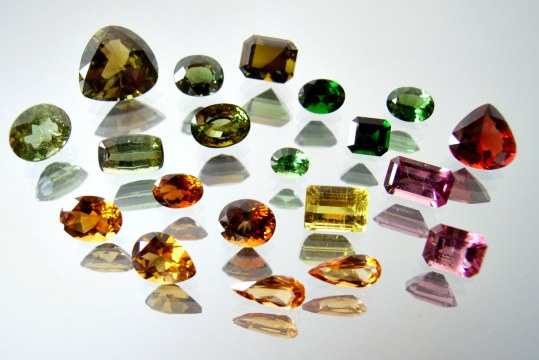 |
| アフリカ大地溝帯の特異な色合いのトルマリン 0.85
- 7.99ct Tourmalines with peculiar shades from African Great Rift Valley |
アフリカ大地溝帯のトルマリン
(Tourmalines of
African Great Rift Valley)
 |
| アフリカ大地溝帯の特異な色合いのトルマリン 0.85
- 7.99ct Tourmalines with peculiar shades from African Great Rift Valley |
アフリカのモザンビークから東海岸を北上してシナイ半島を縦断し、死海北部のシリアにまで達する総延長7000kmに及ぶ幅30〜100km、深さが200m〜数千mに達する巨大な断層陥没帯がアフリカ大地溝帯です。
この地形は地球深部からのホットプルームと呼ばれる巨大なマントル上昇流によって形成されています。
北部ではおよそ4000万年昔に始まりアラビア半島とアフリカ大陸を分離し、エチオピア南部では1700万年昔と比較的新しく、アフリカの東海岸が引き裂かれつつあります。
ケニアからモザンビークまでアフリカ地溝帯南部からはマンガン、クロム、ヴァナジウムを含み赤ー暗褐色ー金色ー緑ーエメラルド・グリーン等の特異な色合いの宝石質のウヴァイトードラヴァイトが採れます。
他の地域には稀なトルマリンが採れる背景には前述の地質学的な環境があると考えられています。
The Great Rift Valley runs north to south for some 7000km, from northern Syria in South East Asia to Central Mozambique in East Africa.
The Valley varies in width from 30 to 100km, and in depth from a few hundred to several thousand meters.
The Great Rift Valley is the result of the rifting and separation of the Africa and Arabian techtonic plates that began 40 million years ago in the north and by the ongoing separation of East Africa from the rest of Africa along the East African Rift, which began about 15 million years ago. The formation of the Rift Valley continues, driven by mantle plumes and ultimately a result of the African superswell.
From Kenya to Mozambique, tourmalines with peculiar colors ; red-dark brown-golden-green-emerald green are mined.
They are mainly rare gemmy uvite-drivite, with higher impurity of mangan, chrome and vanadium, which derives from these geological back ground.
タンザニアのトルマリン(Tourmalines from Tanzania)
ウヴァイトードラヴァイト系のトルマリン (Tanzanian uvite-dravite series tourmaline)
タンザニアは世界で有数の多彩な宝石産地ですが、しかしトルマリンに限ればむしろ貧弱とさえ言えるでしょう。
しかしアジアや北・南米大陸等、他の産地には見られない特異な色合いのトルマリンが報告されます。
左の写真は2005年1月にモロゴロの漂砂鉱床から採れた水磨礫をカットしたトルマリンです。
毎月5−10kg程度の水磨礫が採集され、平均で2〜3カラット、最大で15カラットのルースが得られるとの事です。
分析の結果、これらの石の屈折率は1.622−643、比重は3.05−3.07、化学分析と併せてこれらがウヴァイトードラヴァイト系のトルマリンであると判明しました。
チェルシー・フィルター反応は個々の石により赤味を帯びるもの、或いは無反応と様々で、違いはクロム含有の多寡によるためと考えられます。0.93 - 9.05ct Morogoro, Tanzania
Tanzania, known as one of the richest gem producer, is, however not significant, rather poor producer of tourmalines. But tourmalines with strange colors are reported sporadically. Photo on top is that example ; These tourmalines were recovered as waterworn pebbles weighing 0.1-5grams, from alluvial deposits in Morogoro, Tanzania in January 2005. It is estimated that an average of about 5-10kg per month of fine facetable material was being produced. The faceted tourmalines typically range 0.25 to 3ct, although stones as large as 15ct have been cut. Chemical analysis and physical data of R.I. 1.622-648, and S.G. 3.05-07 revealed them as uvite-dravite tourmaline. Chelsea filtor reaction ; none to medium red.
7.99ct 13.8x14.6mm
Gems & Gemology 2006 Summer 号の上記の6個の写真と情報のおかげでかつて入手した3個のタンザニア産トルマリンの正体がようやく判明しました。
いずれも20年余り昔、ツーソン・ショーにてドイツのカッターからタンザニア産として入手したトルマリンです。
緑と黄色と橙色とが複雑に混じった多色性の石です。
トルマリンは精密な化学分析をしない限り正確な組成が分かりません。
これらがモロゴロ産のウヴァイトードラヴァイト系のトルマリンであることはほぼ間違いありません。
7.99ctのトルマリンはチェルシー・フィルターに反応してやや赤味を帯びます。2.54ct 9.54x7.25mm 1.55ct 8.0x6.85mm
An article of Gems & Gemology( Summer 2006 pp182-183) reminds me of tourmalines in my collection ; top photo of 7.99ct stone and bottom photos of 2.54 and 1.66ct faceted stones. I obtained them about 20 years ago at Tucson from German cutter as tourmalines from Tanzania. They show strong pleochroism between dark to bright green - yellow - brownish orange, depending on differnt viewing angles. I have been wondering which type of tourmaline they belong, but it is almost impposible to determine the tourmaline species without chemical analysis using professional equimpents. Thanks to the article, I can determine them as uvite-dravite series tourmaline, perhaps from the same locality of Morogoro.This stone reacts to become medium red through chelsea filtor.
色変わりを見せるトルマリン
(Tourmaline with an apparent change-of-color in one pleochroic direction)
白熱光(Incandescent light) 蛍光灯(Fluorescent light) Uvite 2.33ct Umbasara, Tanzania
本来多色性が強かったり、一つの結晶に多くの色を持つことがトルマリンでは珍しくありません。
ところがアレクサンドライトや蛍石のような光の種類による顕著な色変わりを見せるトルマリンはありそうで実は稀にしかありません。
が、中には不思議な色変わりを示す例があります。
ただし元々多色のトルマリンですから、注意深く見ないと色変わりが確認できません。
これはアレクサンドライトと間違えないためにも重要な点です。
つまり緑に見える光軸方向にだけ色変わりを示すのです。
白熱光ではブルゴーニュの赤ワインが入っている緑の瓶のように見えますが、自然光相当の蛍光灯では空の瓶だけのように見えると言う、不思議な色変わりを見せます。
左側の写真のトルマリンはスリランカでカットされましたが原石は輸入品です。
分析の結果から、タンザニアのウンバ川産のウヴァイトであることが判明しました。
色変わりの原因は微量に含まれるクロムとヴァナジウムによるものと考えられています。
タンザニアのウンバ川から稀に色変わりを示すトルマリンが採れることが1997年と1999年の英国宝石学協会誌に報告されています。
Tourmaline is a mineral which intrinsically shows strong pleochroism and multi colored crystal are commonly found. However, tourmalines that show alexandrite-like change of color is quite rare. The 2.33ct tourmaline of the photo showing an interesting color shift was reported ; This stone appears strongly pleochroic in reddish brown and green in incandescent light, but looks uniformly green in fluorescent light. When viewd table-up in dayligh-equivalent fluorescent light, this stone is brownish yellowish green, with even color distribution. The overall color shifts only slightly between daylight-equivalent fluorescent light and incandescent light, howeverthe evident pleochroism changed marketedly. Normally pleochroism is determined using polariscope in daylightr-equivalent fluorescent light ; for this sample, these colors were dark yellowish green and brown-orange. In this case, the stone still shows the same brown-orange pleochroic color in incandescent light with much brighter(lighter and much saturated) yellow-green. The overall effect is an oenophile's delight : In incandescent light, this stone resembled red Burgandy wine in its typical green bottle; however, in daylight-equivalent fluorescent light, the bottle looked empty. This stone was cut and purchased in Srilanka, but stone itself was imported. The detailed phisical measurement and chemical analysis revealed this stone as uvite, the caslcium magnesium tourmaline, in good agreement with the tourmaline from Umbasara, Tanzania, which were described in tow reports in the Journal of Gemology Vol. 25, No.5 1997, pp325-330 and Vol. 26, No.6, 1999, pp386-396.
クロム・トルマリン (Chrome Tourmaline)
クロム・トルマリン(Chrome Tourmaline) 2.9x2x1.8cm
Landanai, Tanzania1.04ct 6x6mm 0.46ct 5.5x4.5mmmm 1.56ct 8.1x6.0mm
14x10x6mm 10mm 1.10ct 8.1x6.1mm 1.17ct 6.8x6.0mm 1.31ct 6.4x5.8mm Uvite (Vn.) Burma
19世紀末にビルマ北部のシャン高原を流れるサルウィン川西岸のカレンニ丘陵にて鮮やかなエメラルド・グリーンのウヴァイトが発見され、発色の原因が不純物のクロムによると考えられたためにクロム・トルマリンと命名されました。
後にクロムではなく、ヴァナジウムによる発色と分かりましたが、名前だけはそのまま残されました。
こんにち市場に出るクロム・トルマリンの大半はタンザニア北部のケニアとの国境を流れるウンバ川流域、タンザナイトで名高いメレラニ丘陵のGerevi丘、その南100kmにあるLandanai地区の鉱山等から散発的に供給されています。
これはウヴァイトとドラヴァイトの固容体で、クロムがヴァナジウムと同じか時には多く含まれていますから名実共にクロム・トルマリンとなったわけです。
写真のようにまさにエメラルドを髣髴させる美しい色合いです。
End of 19th century in Burma, on the west bank of Salween River in the Karenni Hills, emerald-green troumaline was reported. This tourmaline was identified as uvite, of which emerald-green color was attributed to chrome. It was in 1956 that cause of color was correctly described not chrome, but vanadium, yet the name chrome tourmaline survived, thenafter.
Presently, Tanzania dominates the supply of chrome tourmaline from Umba River, Merelani and mine of Landanai area, located abougt 100km south of Merelani Hills. Tanzanian chrome tourmaline is a complete uvite-dravite solid solution and containes as much or even higher chrome impurity as vanadium to justify the traditional name.
普通のトルマリン (Tanzanian common tourmaline)
2.49ct 9x8mm 3.35ct 10.6x8.6mm 2.45ct 10.15x6.2mm
タンザニアには無数のペグマタイトがありますから当然トルマリンもあちこちで発見されますが、黒く不透明なショールが大半です。
何故か他の産地では宝石質が稀なウヴァイトードラヴァイト系のトルマリンがここでは前述の褐色ー金色、多色、エメラルド・グリーン等魅力的な色合いの饗宴を展開しています。 とはいっても、写真のように鉄発色による普通の宝石質のトルマリンもないわけではありません。
ブラジル産なら見向きもされないありふれたトルマリンですが、タンザニア産となれば貴重な標本です。
In Tanzania, tourmaline, commonly schorl, is found in pegmatites that are mined for mica. Curiously as before mentioned rare uvite-dravite series, which is rarely gemmy in other localities, shows fascinating brown to golden, multi-color and emerald -green color. Three stones of above photos are, although looks abundant in locality, such as Brazil, common iron colored tourmalines, relatively rare in Tanzania.
ケニアのトルマリン(Tourmalines from Kenya)
ケニアのトルマリンの多くはタンザニアとの国境のウンバ川流域で採れるのでタンザニア産との区別は余り意味がありません。
他では珍しい金色のトルマリンが特徴です。
写真の石は独特の色変わりを見せます : それぞれ白熱光と蛍光灯と単独の照明ではいずれも濃い黄色ですが、同時に両方の光の下では緑がかったレモン色に変化します。
測定と分析の結果では9.9wt.%の酸化マンガンを含むドラヴァイト・トルマリンと判明しました。
独特の色変わりは鉄とチタンイオンによる電荷移動に、さらに微量のヴァナジウムによる影響と推定されます。
Most of tourmalines in Kenya are practically recovered from Umb River, which runs between Kenya-Tanzanian border. We encounter relatively rare yellow species as Kenyan tourmaline. A strange color change type is reported : a dark yellow color seen under fluorescent and incandescent light, but becomes disdtinctly greenish-yellow when illuminated simulaneously with incandesdent light and fluoresdent lighting. Microprobe analysis identified the stone as dravite with approximately 9.9 wt. % MgO. Titanium is the major impurity with minor amounts of vanadium and iron, and traces iof manganese and chromium. Color change is attributed to Fe2+ - Ti4+ charge transfer and V3+ respectively.白熱光と蛍光灯単独の照明
(Single source lighting)両方の照明Incandesent/Fluorescent lighting Dravite 2.56ct
0.85ct x 2 9.8x4.7mm 2.67ct 9.0x6.6mm 4.50 and 3.06ct(12.6x6.7x5.6mm)
ペア・カットの金色の石はまるでインペリアル・トパーズのように見えますが、ケニア産のトルマリンです。
トルマリンとトパーズとは屈折率が極めて近いため、似た色合いの場合は肉眼での識別は殆ど不可能です。
次のエメラルド・カットのレモン・イエローの石もトルマリンには珍しい色合いです。
このような色のトルマリンは東アフリカの他にはビルマのモゴクくらいしかありません。
右端の結晶は金色ー黄色のトルマリンの原石です。
この色合いトルマリンはケニア東岸、タンザニアとの国境のツァヴォ国立公園地域の何ヶ所かのペグマタイト鉱山から1980年頃から報告されるようになりました。
分析の結果ではウヴァイトードラヴァイト系のトルマリンです。
魅力的な色合いはマンガンと微量のクロムを含むためと考えられています。
Pear cut pair stones are not imperial topaz, but tourmalines from Kenya. Because of similar R.I. values of tourmaline and topaz, it is almost impossible to identify them only with unaided eye. Next emerald-cut lemon-yellow tourmaline is from Kenya, too. Except East Africa, tourmalines of these colors are encountered only from Mogok, Burma. Two brownish materials are roughs of these golden to yellow color tourmalines, great probably from pegmatite mines in Tsavo National Park near Tanzanian border, where they have been reported since early 1980. Chemical analysis revealed them as uvite-dravite series with manganese and minor chorome impurity, which are cause of these attractive colors.
ザンビアのトルマリン(Tourmalines from Zambia)
ザンビアは1980年頃に発見されたケニア産に酷似した暗赤色のドラヴァイトで注目を集めました。
さらにマラウィ国境近くで発見されたカナリー・イェローのトルマリンで一躍有名になりました。
しかし、それ以外にも地質地学的な条件による多様な特異な色合いのトルマリンで注目すべき産地です。
Zambian tourmaline became well known around 1980 when it began to produce deep-red schorl-dravite. Large crystals of yellowish manganoan elbaite discovered in 2000 near Malawi border immediately appealed to the world gem market.
Peculiar colored species are being reported one after another.
地質学上の話題を提供したドラヴァイト
(Dravite that excited geologists)
1980年ごろにマラウィ国境近くのザンビアのチパタで発見された稀な暗赤色のドラヴァイトが世界の地質学者の注目を集めました。
なぜなら1975年に1000km以上離れたケニアで報告されたトルマリンとそっくりだったからです。
詳しい分析の結果、その色合いだけでなく成分や屈折率、比重等の特性もまるで双子のように酷似していることが判明しました。
A rare deep-red dravite discovered in Zambia, at Chipata, near Malawi border gathered the hot interests from geologists due to its resemblance to dravite already discovered in 1975 at 1000km far in Kenya. The detailed analysis revealed the extreme similarity not only their color but also chemical composition, Refractrive Index and Specific Gravity as if they were twin.Red dravite 8.5cm
Chipata, Zambia
* : Data not included in the analysis ** : Below the detection limit(0.02%)
K2O Na2O CaO MgO MnO FeO TiO2 SiO2 Al2O3 Cr2O3 V2O3 R.I. S.G. Kenya 0.06 2.7 0.06 9.4 0.03 4.4 0.3 37.9 31.1 * * 1.624-654 3.03-07 Zambia 0.02 2.3 0.14 10.0 0.05 2.1 0.2 36.7 33.9 ** ** 1.623-657 3.07-08
1000km以上も隔たった土地からこのような成分、色合い、屈折率や比重の物理特性がほぼ同一の鉱物が採れたことは、極めて同質の地質学的な条件下で成長したことを示唆します。
そしてザンビアもケニアも同じモザンビーク造山帯のそれぞれ南端と北端とに位置しています。
おそらく地球の深部からの同じ成分のマントル上昇流が1000kmも離れた地点にて極めて似たトルマリンを成長させたと考えられます。
All the physical and optical properties of this Zambian tourmaline indicate that it is very similar to a rare type of dravite found only in one small locality in Kenya. This similarity suggests that a common geologic origin exists between these two areas even though they are a thousand kilometer apart. The localities are sitated at opposit end of Mozambique belt. The fact that both types of tourmalines are so rare and yet so similar, in conjunction with the geologic evidence available, suggests that perhaps the Kenyan and Zambian dravites were generated by the same geologic event.
マンガン・トルマリン (Tourmaline with high manganese contents)
マンガン含有率の高いトルマリン(Tourmalines with high manganese contents) 非加熱(non heated) 加熱後(heated) 38.47ct Zambia
珍しい黄緑色のトルマリンは1986年に報告されました。
この38.47ctの石は類のない色合いと、トルマリンの範疇(0.020)を越える 0.028の副屈折率を示しました。
精密な化学分析により9.2wt.%の高いマンガン成分の含有が明らかになりました。
ザンビアからは既に1980年代初頭からマンガンを6%以上含む異常な濃度の褐色のトルマリンが出現し、加熱により明るい黄緑に処理されたものが市場に出ていました。
同様のトルマリンは1910年ごろにマダガスカルのTsilaizinaから20%もの高いマンガン濃度のものが採れたことがあり、非公式ですがツィレーサイト(Tsilaisite)の名前で流通したことがあります。
ザンビア産にはそれほどの高いマンガンは含まれていませんが、一部市場ではTsilaisiteとして流通しているようです。
Yellowish-green troumaline was reported in 1986. This 38.47ct tourmaline has intriguing vivid color, which has never been seen in gem tourmaline. In addition, this stone gave a birefringence value of 0.028, which is well above the nmaximum typically noted for other gem tourmalines, while other physical data are within the range of tourmalines. Chemical analysis revealed an unusally high level of manganese(9.2 wt.% MnO). Since early 1980、pegmatite localities along the Luangwa River Valley of Zambia produced high manganese bearing tourmalines, which original brownish shade was turned to be bright greenish-yellow after heat treatment and distributed under Tsilaisite. Tsilaisite is an unofficial name given to the high-manganese bearing(about 20%) tourmaline, discovered in Tsilaizina, Madagascar around 1910.
ビスマスを含むトルマリン(Bismuth bearing Tourmaline)
ザンビア・マラウィ国境近くの鉱山の所在地
Pegmatite mine locality near Zambia/Malawi borderルンダジ地区のペグマタイト鉱山
(Pegmatite mine in Lundazi area)
トルマリン団塊のカラーゾーン
(Color zones in nodule)
含ビスマスの多色のトルマリン 3.38 -8.14ct
(Multicolor tourmalines)5.87 and 4.94ct Lundazi, Zambia
1996年にザンビア北東部のマラウィ国境に近いルンダジ地区の漂砂鉱床にてスペッサータインやアクアマリン等と共に多色性の宝石質のトルマリンが発見されました。
屈折率や比重等は普通のエルバイト・トルマリンですが、分析の結果最大で0.49 wt.%(Bi2O3)のビスマスが含まれていることが判明しました。
とりわけピンク色の部分は他の色より10〜30倍もの高濃度です。
一般にトルマリンにはビスマスが含まれることは殆どありません。
例外的にシベリアのMalkhanペグマタイト産のルベライトが最大0.55%のビスマスと鉛とを、またブラジル・パライバの含銅トルマリンも最大で0.83%のビスマスを含む例が知られています。
不純物として含まれるビスマスは色合いや特性には影響を及ぼしていないと考えられます。
発見後の半年余りで100kgのファセット級のラフと低級品数トンが掘り出され、最大では20カラットに達するルースを含んで1万カラット程の多色のトルマリンがカットされました。
In October 1996, multi colored tourmaline was discovered together with spessartine and quamrine etc., at
alluvial deposit of Lundazi, near Malawi border in north-easter Zambia. This is an ordinary elbaite tourmaline with physical and optical data within the range of normal tourmaline. However chemical analysis using EDXRF revealed that this tourmaline is unusally rich in bismuth(up to 0.49 wt.%). The pink colored part has 10 to 30 times higher bismuth contents than other color parts. Examples of Bi-bearing tourmalinme are relatively uncommon. In an exhaustive literature serrch, Dietrich(1985) noted trace amounts of Bi in dravite-uvite and schorl tourmalines but not in elbaite. Rubellites from miarolitic granitic pegmatite in Malkhan Range in Central Transbaikal, Russia that contained both Bi(up to 0.55 wt.%) and lead. The elbaite from São Jose da Batalha, Paraiba, Brazil, are known for their copper contents, together with up to 0.83 wt.% Bi2O3.
カナリア・トルマリン (Canary tourmaline)
6.0 - 25.0ct 0.89ct
7.7x6.6mm1.58ct
8.5x6.6mmショールの中のカナリア・トルマリン
Gem-quality yellow
tourmaline in schorl 6.5cm加熱前
(Before heating)550℃で2時間加熱後
after heated for
two hours at 550℃Kabelubelu Mining area, Zambia
かつて"double blue" アクアマリン
を産したカナリア鉱区
Canary Mining Area,
once a sourc of
"double blue" aquamarineペグマタイト鉱脈
(Pegmatite vein)重機による初生鉱床の採掘 2003-2004
Exploration of primary deposits
with large excavator
カナリア初生鉱床下部の二次鉱床
(Secondary deposits downslope
from the main Canary pegmatite)
Before treatment, the rough was brown to brownish-yellow. Because the tourmaline typically contains black needle-like inclusions, 95% of the rough yields faceted gems that are less than one carat. Most of the finished stones are 0.10-0.50ct. Production has been quite steady at approximately 10,000 carats per month. Currently 95% of the production is being sold in Japan. Microprobe analysis recorded an enrichment in manganese(6.93 wt.% MnO). The bright yellow color is attributed to Mn2+ - Ti4+ intervalence charge transfer.
2000年秋に”カナリア・トルマリン”と呼ばれる明るい黄色のトルマリンが発見されました。
当初マラウィ産と伝えられましたが、実際はマラウィ国境付近のザンビア側のルンダジに近いカナリア鉱区のペグマタイトでした。
他に類を見ない明るい黄色は、6.93%と高いマンガンの含有率によるMn2+ ーTi4+荷電子間電荷移動によるものと考えられています。
ただし天然でこの発色は少なく大半は褐色ー黄色の原石を加熱処理して得られるものです。
結晶には黒い針状の包有物が多いためルースの殆どは0.1−0.5カラットの小さなものしか得られません。
毎月1000カラット程の安定した生産がありますが、その95%は珍しい宝石にいささか過剰な情熱を注ぐ日本市場に吸収されています。
A new deposit of electric yellow and greenish yellow tourmalines was discovered in fall 2000 at Canary area pegmatite, Zambia near Malawi border. The bright yellow gems are being marketed as "Canary" tourmaline. Although some of the material is natural color, much of it has been heat treated to achieve the "electric" yellow color.
モザンビークのトルマリン (Tourmalines of Mozambique)
モザンビークは下記の結晶写真のように大きく見事なトルマリンを産します。
が、その多くはウヴァイトードラヴァイト系の余りにも多彩な暗い色合いのために、宝飾用としてよりはむしろルースのコレクター向けにカットされるものが大半でした。
ところが2000年代以降、ブラジルのパライバ産と同じく銅とマンガンとの発色の鮮やかな色合いのトルマリンが発見され、しかもかなりの量が安定して採れるため一躍注目を集め始めました。モザンビークのトルマリン
0.94 - 4.39ct
Moazmbique TourmalinesAlthough Mozambique used to produce superb tourmaline crystals, most of them are uvite-drive series with dark multi-color type and are faceted mainly for collectors,n rathan than for jewelery purpose. Hoever, since beginning of 2000, Paraiba type cuprian elbaite were discovered and created sensations in gem trade for their brillant color and stable production.
モザンビーク北東部の地質(Geology of North-Eastern Mozambique)
モザンビーク造山帯の一部を成す豊かな宝石と鉱物資源に富むペグマタイト脈がモザンビーク北東部からケニア、タンザニアへと延びています。
モザンビークのペグマタイト脈の大半はカンブリア期前の広大な片岩、片麻岩、変成堆積岩等の太古の岩盤に中生代に何度かに渡って貫入した花崗岩と変成岩によって形成されました。
The pegmatite district oies within the Gneiss-Migmatite Complex , a huge area of metamorphic rocks and granite intrusions of pre-Karroo age. These rocks are part of the Mozambique Belt, which has yielded rich mineral and gem wealth from Mozambique through Kenya and Tanzania. Pegmatites are quite common throughout the Precambrian rocks of Mozambique.
第四紀(Quaternary) 第三紀 (Terciary) 白亜紀(Cretaceous)
堆積層(Sediment)
アルカリ溶岩層(Alcali lava)中生代カルー期(Karroo)
堆積層(Sediment)
溶岩流(Acid & basaltic lava)
深成岩(Plutonic Rocks)
塩基性岩(Basic Rocks)
花崗岩(Granite)
Naica Mine ca.1955 鉱山への鉄道(Narrow-guage railroad)
Muiane Mineムイアーネ鉱山の採掘光景 1955年
Primitive mining at the Muiane mine
巨大な緑柱石結晶(Large beryl crystal) アルト リゴーニャ ペグマタイト地区の鉱山(The Alto Ligonha pegmatite area mines) モルガナイトの採掘(Morganite mining)
Mocachaia Mine
モザンビークのペグマタイト(Pegmatites of Mozambique)
モザンビークの豊かな鉱物資源は10世紀頃には既にインドやアラビアの航海者によって知られていました。
19世紀末にポルトガルの植民地となってからは金とピンクのトルマリンとインド洋から150km内陸のアルト・リゴーニャとその南のムイアーネのペグマタイト鉱脈で発見され、さらに周囲の豊かな鉱床が次々と開発されました。
モザンビーク産の鉱物の多くがアルト・リゴーニャ産されているのはそのためですが、必ずしも本当の産地か否かは確かではありません。
その周囲3万平方kmと広大なペグマタイト地帯が広がっています。
ペグマタイト鉱床は重要な宝石の産出鉱床ですが、しかし一般には宝石より、有力な鉱物資源を目的に開発と採鉱とが行われます。
モザンビークでは金の他にベリリウム、ニオブータンタル、リチウム、ビスマス、トリウム等希少金属と雲母、カオリン等の産業資源が採掘されてきました。下記の表はかつて採掘された資源の記録です ; 単位(unit) : トン(tons)
緑柱石 Beryl コルンブ石-
タンタル石Columbite-Tantaliteトルマリン Tourmaline リチウム鉱石 Lithium ore 雲母 Micas サマルスキー石 Samarskite 輝蒼鉛鉱 Bismuthinite モナズ石Monazite カオリン Kaolin 1937〜 1958 7,300 570 1.4 10,300 150 20 20 15 650 1962 440 110 - 200 1 - 15 - -
Rich mineral resources of Mozambique were recognized already in 10th centuries by Indian and Arabian navigators.
After Portuguese colonialization in late 19th centuries, gold and gem pink tourmaline were discovered in pegmatite veins at Alto Ligonha and nearby Muiane, followed by disdoveries of rich ores in surrounding area.
Alto Ligonha, 150km inland from the coast of Indian Ocean is in the center of one of the world's largest pegmatite districts. It develops over 30,000 km2 and is home to hundreds of quarries, mines and prospects, producing beryllium, lithium, tantalum, bismuth, thorium, micas, kaolines etc., mainly as industrial resources.
モザンビークのトルマリン結晶 (Tourmaline crystals of Mozambique)
3cm 3.1cm 7.8cm 7.7cm 16cm William Larson Collection Harvard University Collection Smithsonian Collection Muiane Mine Nacala Mine Alto Ligonha
これら二つのトルマリンはごく普通の品質のエルバイトです。
最初に発見され、ドイツのおそらくはイダー・オーバーシュタインにてカットされたピンクのトルマリンもこんなだったかもしれません。
アメリカの最上のカッターによる仕上げが見事です。
These faceted stones are of common quality elbaite. But their remarkable finishing by skilfull American cutter remind me of the first discovered pink tourmalines at Alto Ligonha and faceted stones, probably cut at Idar-Oberstein, Germany.1.62ct 7.7x6.2mm 1.87ct 9.8x6.8mm
1.39ct 7.6x6.6mm 1.31ct Ø6.5mm 1.81ct 8.6x5.35mm
写真の3つのトルマリンはいずれもインペリアルトパーズのような色合いです。
トルマリンとトパーズとは屈折率、比重共にほぼ近接した値を示すため時に混同されることがあります。
ただし市場価格もほぼ同じ水準ですから間違っていたところで問題にはなりません。
これらはしかし確かにトルマリンです。
いずれもモザンビーク産としては珍しく美しい色合いのトルマリンと言えましょう。
Three tourmalines in this photo looks like imperial topazes. Indeed both tourmaline and topze have close density and refractive index and are tend to be confused. However it would not cause serious troubles because their market price is close, too. These tourmalines have rather rare attractive colors as Mozambique elbaite.
3.53ct 10.2x8.3mm 0.96 - 2.28ct 1.93ct 8.2x6.85mm 2.59ct 8.8x7.0mm
3.53カラットの褐色の石は典型的なウヴァイトードラヴァイトです。
光の当たり加減によっては素晴らしいな金色の煌き見せます。
下の多色の石と同じアメリカの一流のカッターの手になる切れ味の良いカットが見事です。
次の3個は20年以上昔に当時は珍しいモザンビーク産としてともかく入手した標本級の石です。
次の二つはごく最近入手した、パステル・カラーのエルバイト。地味ですが、しかし魅力的な多色性を見せてくれます。
First 3.53 carat stone is a typical uvaite-dravite. Bright golden color sparks out when turned in illumination. This stone was finished by same top cutter in U.S.A. as the stone of lower photos. Three pale color stones are old aquisition of over 20 years, while tourmalines were of rarity. Two following stones in pastel color are recent aquisition. They show attractive multi-colors when viewd from different angles and illuminations.
4.39ct 9.6x7.8mm Mozambique
左端の何とも見栄えのしない色合いの写真をネット上で見かけて、カラット当たり7ドルと格安の値段と、珍しいモザンビーク産とに注目して入手しました。
実物を手にとってその魔法のような色の変化に感嘆した次第です。
側面から見た繊細なパステル・グリーンにはため息がでます。
アメリカを代表するカッター集団の手になる作品ですからカットの素晴らしさが色合いの変化を際立たせますが、その真の魅力は手にとって眺めて初めて分かります。
Could dark-brown color, like upper left photo appealed to my attention, if it were not super bargain priced as low as US$7.00 per carat for a rare Mozambique tourmaline ? This facetted tourmaline revealed it's fascinating metamorphosis, fianlly in my hand. I could not stop sighing with its delicate pastel green seen from side of stone. The cutting skill by Coast to Coast rare stone cutter could be well appreciated only when this stone is viewed on hand.
3.46ct 10.6mm 1.62ct 9.15x6.85mm 1.40ct 9.25x6.80mm 0.94ct 7.55x5.25ct Mozambique
ルクセンブルグとフランス国境に近いドイツ側に小さな地図には載っていないイダー・オーバーシュタインの町があります。かつて瑪瑙や紫水晶が採れたことから宝石の研磨によって発展し、自前の鉱脈が枯渇した現在も高度な技術により、世界の宝石産業の中心地として君臨している町です。
世界最大のツーソンの宝石フェアにはこの町の一大集団が主会場であるホリデイ・イン・ホテルの一角に30余りのブースを構えています。
話題の新種の宝石は、まず彼らのブースに立ち寄ってその最大限の美しさを確かめると言うのがツーソン訪問の一つの楽しみでもあります。
写真の宝石は、そのイダー・オーバーシュタインのさらに郊外の小さな町、キルシェンワイラー(Kirschenweiler)に住む代々500年来の宝石カッターが自ら入手した結晶をカットして売っていたので産地が確かなものです。
と言っても集散地のアルト・リゴーニャ経由なので正確な鉱山等までは分かりません。
今でこそ稀なウヴァイトードラヴァイト系のトルマリンと分かりますが、当時はそんな区別が付くはずもなく、珍しいモザンビーク産と、やや褐色を帯びた紅や、明るい金色の見事なカットに惹かれて入手したものです。
A town of Idar-Oberstein, Germany lies close to both French and Luxenbourger border. This town developped for gem industries cutting agates and amethyst mined in the town. After their own gem resources exhausgted, people maintained their cutting skill to become one of the leading gem cutting center in the world, today. When you visit Tucson Show, do not miss their exciting booses of over 30 blocks, housed in Holiday Inn Broadway Hotel. Brownish-red and golden tourmalines of photo were facetted by an independent cutter from small town Kirschenweiler in the suburb of Idar-Oberstein. His family has been cutting gems since 1502, buying roughs direct from original source. I purchased these tourmalines about 20 years ago, just for their charming color thanks to their superb cutting skill and strange locality as Mozambique. Now, I know they belong to rare gem species of uvite-dravite tourmalines.
モザンビークのパライバ型トルマリン(Paraiba-type tourmaline from Mozambique)
1.75ct 10x6x4mm 2.22ct 11.2x7.2mm 1.02ct 7.7x5.8x3.3mm 1.81ct 8.8x6.8x4.6mm 5.16ct 12.8x9.7x5.7mm
銅とマンガンを含み輝かしい色合いを見せるトルマリンが1989年にブラジルのパライバ州で最初に発見され、次いで隣接するリオ・グランデ・ド・ノルテ州でも発見されました。
さらに2001年以降にアフリカのナイジェリアで3ヶ所、モザンビークにも新たな産地が発見されました。
モザンビークのトルマリンの多くは淡い色合いですが、中には数十カラットに達する大きく透明なもの、またブラジルのパライバ産に匹敵する濃い色合いの石もあり、かなりの量の石が安定して供給され始めているために注目を集めています。
含まれる銅とマンガンとその他にふくまれる金属不純物の比率により多彩な色合いを示しますが、現在では青ー青緑の輝かしい色合いのものは産地を問わずパライバ・トルマリンと総称されます。
100年も昔からトルマリンが採掘されて来たモザンビークに新たにパライバ型のトルマリンが発見された事実には驚かされました。
当初アルト・リゴーニャとされていましたが、最近になってようやく100km余り東南のマヴコ近郊の新しい産地であることが判明しました。
Bright color Cu-bearing tourmaline, so-called ; neon-blue, electric blue etc., were first discovered at Paraiba in 1989, followed by new mines in neighboring Rio Grande do Norte State, Brazil during the 1990s. Then, after 2001, similar tourmaline discovery were reported from three localities in Nigeria and one new locality in Mozambique, Africa. Although most of Mozambique troumaline has relatively pale color, some are equivalent as original Paraiba one and several tens of carat stones are not rare. Mozambique troumaline now creates sensations in gem trade for its stable and rich production.
These troumalines are clasified as elbaite tourmaline with cupper and manganese and color varies depending on impurity ratio of other metalic ions. After long confusion on nomenclature, blue to green Cu-bearing troumaline is called officialy as paraiba troumaline in gem trades.
It was a great surprise that rare Cu-bearing tourmaline was newly discovered in Mozambique, where pegmatite mining started over 100 years ago. Although it was reported from Alto Ligonha first, but recent report revealed the new mine near Mavuco area, located about 100km south east from Alto Ligonha.
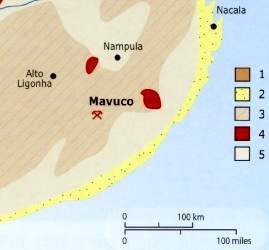 |
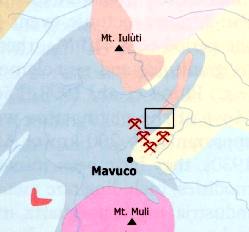 |
 |
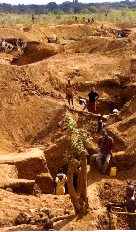 | ||||||||||
| アルト・リゴーニャ・ペグマタイト地帯の パライバ・トルマリンの新産地マヴコ地域 Mavuco Cu-bearing tourmaline locality on the eastern side of well-known Alto-Ligonha pegmatite distric |
イウルチ山とムリ山の二つの花崗岩塊の山 の中間にあるトルマリンの漂砂鉱床地帯 The Cu-bearing tourmaline deposit, situated approximatelly between two granitic massifs, Mt.Muli and M t. Iuluti. |
南のムリ山からのマヴコの集落と背景に風化した 赤褐色のラテライト層のトルマリン鉱床 This view of the Mavuco area from the top of Mt.Muli shows a portion of the town and the weatered red-brown laterite that denotesthe mining area in the background |
深さ0.5−5mの トルマリン漂砂鉱床 Alluvial deposit of 0.5-5m depth | ||||||||||
新産地の地質と採掘(Geology and mining at Mavuco)
広大なアルト・リゴーニャ・ペグマタイト地帯の南東部のマヴコ集落の近くで耕作中の農夫がトルマリンを発見したのは2001年でした。
しかしそれが銅を含むパライバ型トルマリンであると判明したのは2003年、モザンビーク原産の含銅パライバ・トルマリンであると公表されたのは2005年の9月でした。
その間採掘された石は大部分がブラジル産として流通していたと考えられます。
トルマリンは凡そ3平方kmの広さの風化したラテライトに覆われた土地の地下50cmから5mの深さの、主に黒雲母を含む片麻岩盤上の漂砂鉱床にやや角が取れた水磨礫として発見されます。
この発見に先立つ1980年央から1990年代末に近くのペグマタイトにアクアマリンと水晶の結晶が発見され、採掘も行われてていました。が、厚い堆積層に覆われていた含銅トルマリンの漂砂鉱床の発見には至りませんでした。
この地の近くに他にも様々な石英、長石、ショール、時に緑柱石を含むペグマタイトの露頭がありますが銅を含むトルマリンは未発見です。
この漂砂鉱床の元となった初生のペグマタイトが何処なのかは不明で現在探索調査が行われています。
トルマリンの発見当初は7000人もの現地人が至る所を掘り返していましたが、現在は正規の採掘権を得た Mozambique Gems 社に雇われた32人の鉱夫がつるはしとシャベルで採掘しています。
1年の殆どは雨が降らず、水不足ため採掘した土砂からの選鉱は困難です。
同社は2008年半ばに1日150−200トンの土砂を処理出来るウォーター・ジェット・プラントを建設中です。
さらにこの鉱区の周囲の鉱区でもブルドーザー等の重機による探索と採掘とが始まっていて、正規と不正規とを含めて少なくとも600人程の鉱夫がこの地域で採掘していると推定されています。
2008年初頭までに数百kgの原石が採掘され、その10%が加熱処理なしでもパライバのような青ー緑の色を示します。今後は更なる鉱脈の発見と生産の増大とが期待されています。
It was in 2001 that a farmer discovered vivid colored troumalines near the village of Mavuco.
In 2003, a parcel of this troumaline sold in the United States was found to contain traces of copper.
But it was not widly sold with its Mozambique origine disclosed until September 2005.
Troumalines are mined from alluvial deposits in an approximately 3 km2 area near mavuco in the easter portion of Alto Ligonha pegmatite district.
The Cu-bearing troumaline has only been found as waterworn pebbles in secondary deposits.
The troumaline-bearing layer rests ion top of weathered biotite gneiss bedrock, and itself is covered by a red-brown to black tropically weatered horizon in thickness from approximately 0.5m near seasonal strem to typically 3-5m. Prior to this discovery, fine cryustals of quartz, troumalines and aquamarines were discovered in the nearby pegmatite outcrops during the mid-1980s to the late 1990s and some of them were mined but Cu-bearing tourmaline layer of Mavuco area was not recognized due to thick overburden. The extent of the troumaline bearing horizon has not yet been determined and the primary deposit of Cu-bearing troumalines, neither.
When mining started, more than 7000 people rushed for mining. Today Mozambique Gems who aquired the legal mining writ employes 32 minors who works with shovels and picks. Due to scareceness or unavailability of water during most of the year, gem recovery by artisanal mining is difficult. The company is building a washing plant capable of processing 150-200 tonnes of material per day, followed by mechanized mining with heavy materials by mid 2008. Mechanized mining with estimated over 600 workers and wider scale exploration started in the surrounding area may also result in the discovery of new areas.
 |
 |
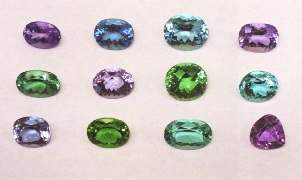 |
| ラテライト層の下の白っぽい漂砂鉱床層 Tourmaline is found in a light reddish brown quartz-rich gravel. |
非加熱の水磨礫 0.3−1.1g Unheated waterworn pebbles |
非加熱のルース 1.69 − 3.76ct Unheated faceted stones. |
左の写真の白っぽい堆積層が黒雲母・片麻岩盤とラテライト層の間のトルマリンを含む漂砂鉱床です。
この漂砂鉱床は水磨礫の磨耗の様子から、恐らくは急激な洪水によりそれほど遠くない初生鉱床から押し流された堆積によって出来たと推定されます。
中央の写真の水磨礫はナムプラの町で得られた非加熱のトルマリン原石のパーセルです。
左2列目の三角形の石は紫水晶、中央右から3番目の白っぽい四角は螢石、その下はガラスと、早くも原石に贋物が混入しています。右の写真のルースはいずれも非加熱ですが、多彩な色合いを示します。
分析の結果ではいずれのトルマリンにも銅やマンガンが含まれています。
酸化銅が最大で0.66wt.%、酸化マンガンが3.09wt.%含まれます。
酸化マンガンを0.2%以上含むとピンクに、さらに2%と濃度が高くなるにしたがって濃い紫の発色に、0.3%以上の酸化銅が含まれると青、鉄とチタンの不純物の含有度が高いと緑の発色となります。
これらの不純物の含有比で多彩な発色が起こり、さらに加熱処理によって色合いが変わります。
最も人気の高いネオン・ブルーの石は大半が加熱処理されていると考えるべきでしょう。
The large pit in the left photo shows a good cross-section of the troumaline deposit in a light reddish brown quartz-rich gravel layer on top of light tan weathered bedrock of biotite.gneiss. This layer is suggested, by angular water-worn pebbles, a fluvial origine, deposited by a stream or river, transported downhill through spasmodic flash floods, from primary deposit(distances on the order of 10km or less). Center photo with unheated rough troumalines are obtained in Nampula. Three of the samples are imitations: an amethyst, somewhat triagular purple piece onthe left), a very klight yellowish green fluorite(center inthe 3rd line from right) and a light bluish green below the fluorite.
Right photo shows a wide range of natural, unheated colors of Mozambique Cu-bearing troumalines.
Extended chemical analysis revealed color cause of Mozambique troumalines as follows ;
All toumaline contains copper and manganese ; up to 0.66wt.% CuO and 3.09 wt.% MnO. Pink color is caused by minmum 0.2wt.% MnO. Higher MnO concentrations of MnO results in purple and violet. blue color is caused by 0.3wt.% of CuO concentration. About 1wt.% Fe with 300ppm of Ti concentration are cause of gree to yellowsh green color.
加熱処理による色の変化(Color change by heat treatment)
ルース(6.75-15.77ct)と水磨礫
青い石は加熱処理後の色
Faceted stones and
water-worn pebbles
All but the blue stone are unheated.非加熱のパライバトルマリン 10.55-16.50ct
Reportedly unheated stones of vivid colors同じ結晶片の色の変化
加熱前(下)と加熱後(上)
Each pair of polished plates,sliced
from the same piece of rough
Upper pieces are after heated and
bottompieces are before heating.
上段(加熱後)と下段(非加熱)との色変化の比較 0.42 - 0.85ct Comparison of color change ; after(top raw) and before(bottom raw) of Cu-bearing tourmalines
人気の高いネオン・ブルーの発色は主に還元雰囲気中での加熱処理によって得られます。
例えば加熱前の紫色の発色は二価の銅イオンによって起こる赤から赤外線領域への広範な波長帯域の吸収と、三価のマンガンイオンによって520nmの波長の青から緑の帯域の光が吸収されるために相対的に短い波長帯域の紫が際立つために起こります。
還元雰囲気中での加熱により三価マンガンが二価のマンガンへと変わって青から緑の帯域の吸収が無くなり、一方銅イオンによる長波長帯域の吸収は大きな影響を受けないため、相対的に青ー緑の発色が優勢になるという仕組みです。
加熱処理で起こった色の変化は安定していて日常の使用では褪色したり、元の色に戻ることはありません。
Most popular neon-blue color is obtained by heat treatment of stones at 530℃ for three hous in the reducing atmosphere.
All stones showed two distinctive broad bands cntered at 〜700nm and 900nm, caused by Cu2+ absorption . In addition, the unheated violet stones also exhibited a broad absorption between〜 500 and 550nm due to Mn3+, causing a transmission window at 〜400-430nm that produced the violet color. Reduction of the Mn3+ absorption band is the major change noted as the result of heating of the violet and darker blue tourmaline samples. Most of the green stones showed little change in Vis-NIR absorption after heating.
Colors after heat treatment is stable and never fades nor returns to original colors under normal uses.
 |
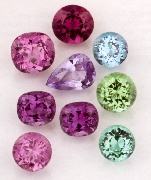 |
 |
 |
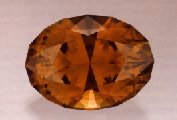 | |||
| 最大級の加熱トルマリン 88.07ct 右は1カラットのダイアモンド The largest heated paraiba tourmaline with 1ct diamond |
非加熱のパライバ型トルマリン 1.28 - 3.02ct Unheated Cu-bearing tourmalines |
銅を含むがパライバ型の色を 示さないトルマリン Cu-bearing tourmalines in less common colors 上(top) 3.71-17.49ct) 下(bottom) 80.54ct |
ナイジェリア新産地の パライバ型トルマリン 0.31-1.04ct Cu-bearing touramlines from New locality in Nigeria. |
原産地であるブラジルのパライバ産と比較してモザンビーク産のトルマリンは比較的に淡い色合いが多いのが特徴です。しかし大きく透明度の高いルースがかなりの量、安定して供給され始めました。
最上級品はパライバ産に匹敵すると言えるでしょう。
そして色合いや包有物次第では宝石質のルースがカラット当たり100〜200ドル程度と急速に妥当な水準になって来ています。
恐らく2008年央以降、重機による本格的な採掘が始まり、供給量が飛躍的に増えたためと考えられます。
宝石の価格はしかし、同じ大きさでも、カット、色合い、濃淡、包有物の有無等々、個々の石ごとに千差万別であり、10倍から100倍もの値差がつくものです。
まして人気が高く品薄のパライバ・トルマリンとなれば値差が開くのも止むを得ません。
モザンビークでの発見と供給急増とによりパライバ・トルマリンの市場価格は現在混乱の只中にありますが、1年もすれば妥当な水準に落ち着くと考えられます。
加熱処理により最も人気が高く高価なネオン・ブルーに変わります。
が、加熱すればネオン・ブルーになる紫の石も非加熱処理のままの石もかなりの量を市場で見かけます。
また2007年末にナイジェリアの新産地から発見された同じタイプのトルマリンは驚くほどモザンビーク産と似た色合いです。
産地の正確な識別は、しかし専門の宝石鑑別機関によるガリウム、鉛ビスマス等々微量の不純物含有比率の精密分析により可能です。
Mozambique troumalines are in general relatively pale compared with original Paraiba troumalines. The best one is equivalent to the Paraiba stones. Today large and transparent stones are abundant and stable production started, resulting in the affordable price level of US$100 to 200 per carat for moderate quality stones. Price vries 10 to 100 times, depending on stone size, color, inclusions, cutting skil, etc, respectively. Today, because of Mozambique factor, there are considerable price confusion in the market yet, that will be stabilized within a year.
Although most popular and expensive neon-blue color is obtained by heating, unheated purple to violet stones are often seen in the market.
In late 2007, new locality of Paraiba troumaline was reported from Nigeria. Stones recovered from this locality terribly resembles that of Mozambique ones. It is possible to identify origine of stones by analysing detailed contents of minor Ga,Pb, and Bi impurity at laboratories.
| Top | Gem Hall |